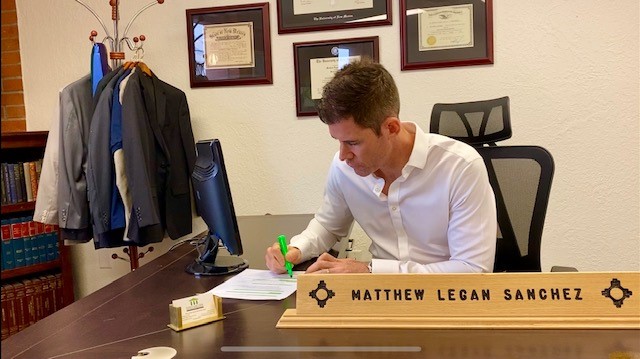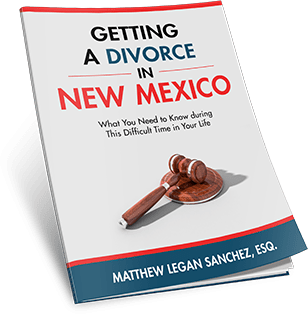
Stalled or stopped divorce in Albuquerque, New Mexico
A home divided cannot stand.
Often people come into relationships with varying levels of education, work experience, property, debt, and income. Over the course of the relationship the parties learn to accommodate each other in order to level the foundation for their home. Possibly one person becomes primarily concerned with cooking, cleaning and raising the children. Taking on these responsibilities in turn allows the other person to focus their energy on education, training or furthering a career. As time passes, each person in the marriage tends to specialize in different areas, creating a more efficient and stable foundation for future growth.
Disaster strikes. For any number of reasons the foundation is uprooted and the parties consider separation.
Suddenly the playing field is uneven. The system that was developed during the marriage to create a stable and efficient household, leaves each person on different ends of a see-saw once the relationship ends.
The parties seek a divorce. During the process of divorce each side may discover that they have competing interests. One side may have more income, property, retirement accounts, or any number of assets that they wish to pocket once the divorce is finalized. The other side may desire primary custody of the children, child support, alimony, and a portion of the assets that were accumulated during the marriage.
The divorce is filed. The divorce inches along at a snail’s pace. Days turn into weeks and weeks turn into months. The case seems to be going nowhere quickly. Over time one party realizes that the other side is stalling, as time continues to tick away with the divorce at a standstill. Suddenly you find yourself with a stalled or stopped divorce in Albuquerque, New Mexico.
Here are the top ten reasons that I’ve observed for a stalled or stopped divorce in New Mexico:
10. I Don’t Know How to Move My Divorce Forward
Divorce is not a self-propelling process like a criminal case, where the state moves the case from arraignment to trial based on impending deadlines and the defendant’s right to a speedy trial.
With divorce cases the parties are required to move the case from start to finish – or from Petition to Final Decree of Dissolution of Marriage. Ultimately it is the parties’ responsibility to clean up a breakdown in the process, ushering the case along to the finish line.
At times parties to a divorce initially believe that they can resolve the divorce without the help of an attorney. A Petition is filed and then the case flat-lines. The parties might be unsure on what documents need to be filed. Possibly prior agreements turn into current disagreements. Emotions flair. Nothing is filed. Months pass and the case goes nowhere. In some situations, the case stalls for 182 days – or six months – and then the case is dismissed for lack of prosecution, requiring the parties to re-open the case.
In situations where no children are involved, the court will not grant a final decree of dissolution of marriage without a valid Marital Settlement Agreement (“MSA”) that distributes the parties’ assets and liabilities. Alternatively, when children are involved, the court requires both an MSA and a valid Parenting Plan to be filed before a Final Decree is granted. At times, the court refuses to grant a Final Decree based on the parties filing a Parenting Plan that does not meet all of the statutory requirements – such as a valid child support worksheet being completed, signed and attached.
9. Interim Support is Higher than Alimony or Child Support
Interim support is spousal support that one party receives in certain situations while a divorce is pending. Alimony, on the other hand, is spousal support that is granted in certain situations when the divorce is finalized. When children are involved, similar to alimony, child support is granted once the divorce is finalized.
For more information on Interim Support, click here: Calculating Interim Support in New Mexico.
For more information on Child Support, click here: Calculating Child Support in New Mexico.
For more information on Alimony, click here: Calculating Alimony in New Mexico.
At times a party may be entitled to Interim Support, while the divorce is pending, but not Alimony or Child Support once the divorce is finalized. In other situations a party may be entitled to a higher amount of Interim Support relative to either Alimony or Child Support.
In other words, Interim Support, Alimony, and Child Support are not created equally. Based on this fact, a party receiving Interim Support might have an incentive to stall the divorce for as long as possible, stretching out the Interim Support payment indefinitely.
8. Lost Control and Desire to Manipulate the Situation
Many relationships turn toxic due to one person’s desire to control every aspect of the other person’s life. At times the relationship ends and the controlling party is left reeling and grasping at straws based on their sense of lost control.
Possibly the controlling person doesn’t want the relationship to end, or simply wants to maintain a degree of control over the other person’s life.
In order to maintain a sense of control, the controlling person may stall and manipulate the divorce in any number of ways.
In situations where the divorce should be decided amicably, the controlling individual might refuse the terms and/or to sign the paperwork necessary to complete an uncontested divorce. Next, the person can make it difficult to be served with the necessary paperwork that gets the process started. Once the process begins, the person can file unnecessary motions, or otherwise refuse to provide requested documents. Finally, once the case reaches settlement facilitation the unreasonable party could refuse to settle the case in good faith – instead demanding a trial to further stretch out the case.
Overall this person makes the process as difficult as possible with the ultimate goal of interfering with the other person’s life, preventing that person from moving to another chapter.
7. Larger Slice of the Other Parties’ Separate Property
New Mexico is a community property state. Generally speaking, this means that any assets, debts or property that were accumulated during the marriage – other than gifts, inheritances, bequests, or pain and suffering awards – are considered community property and will be split 50-50 upon divorce.
On the other hand, generally speaking, separate property means that all of the assets and debts that were accumulated before the marriage remain the accumulating parties’ assets or debts.
At times this clear rule becomes blurred.
In certain situations a person’s separate property can become community property, through a process known as commingling. In this limited circumstance, one party may have a considered interest to stretch out the divorce as long as possible in order to increase one’s slice of the other parties’ separate property that has transformed into community property.
For more information on how Separate Property can become Community Property, click here: When Does Separate Property Become Community Property?
6. The Kids
At times one party drags their feet on a divorce for the children. Possibly the reluctant party simply wants to stay in the marital residence with the children. In this same vein, this person might be the product of a broken home and does not want to subject their child to the hardships of divorce.
In other situations, one parent has heard ghost stories about child support and has an abject terror of paying child support once divorced. At times this person follows the mantra of “cheaper to keep ‘em” and would rather stretch out the marriage rather than being forced to pay the other party child support.
Ultimately there are a number of reasons why one person stalls a divorce based in whole or in part on behalf of the children.
5. Foreclosure & Lower Cost of Shared Expenses
Being single is expensive. There are many financial benefits of living together and pooling fixed monthly expenses. Often the cost of separate homes, separate utilities, and separate living expenses greatly trumps the expenses one incurs while living in the same home and sharing the burden of these necessary expenses.
For some people, the financial benefits of sharing expenses also creates an incentive to either remain in an unhappy relationship, or to stretch out a divorce.
Foreclosure is also a reality affecting millions of Americans. In many situations, a family facing foreclosure can stretch out the process for several years – living in the home without a mortgage payment while the process is pending. When this occurs, both parties living in the home may be reluctant to move away from the mortgage-free home, opting instead to stretch out the divorce.
4. Health Insurance
Never underestimate the power of health insurance to keep a marriage intact. In situations where one person is covered under a spouse’s insurance, the allure of health benefits can prove to be a strong enough tonic to entice one to endure a toxic relationship – or to stretch out the marriage by creating a difficult divorce.
3. Alimony
Length of marriage is the most important factor determining the amount of time that a person receives alimony upon divorce. In the eyes of the law, a couple is considered married until the day that a Final Decree of Dissolution of Marriage is entered. As such, the longer one stretches out a marriage, the longer one can potentially receive alimony once divorced.
For more information on Alimony, click here: Alimony in New Mexico.
2. Bigger Interest in Community Property
Generally speaking, all property that either spouse acquires during a marriage, from community income, is considered community property. Because New Mexico is a community property state, this community property is then split in half upon divorce.
There is a common misconception floating around New Mexico that the date of separation draws a line in the sand, and any property acquired after this date is one’s separate property. Allow me to smash this false notion to pieces. Generally speaking, all of the property that either party accumulates after the separation is still considered community property, until a Final Decree of Dissolution of Marriage is entered.
For many people the following hypothetical is an unfortunate reality. Let’s assume that a couple is married but has been separated for years and years. During this period of separation one person has accumulated a number of assets and property. Times ticks by. On a peaceful summer afternoon, this same person comes to the shocking discovery that the other spouse is entitled to a one-half interest in all of the property and assets that were accumulated after the separation, but before the divorce.
Lesson: don’t assume that everything that one acquires after separation is one’s separate property.
The lesson that we’ve learned is also the reason why some people have an incentive to stretch out a divorce – thereby increasing one’s share of community property. In other words, every day that one is married creates a bigger pool of one’s interest in community property.
1. Denial
Denial blinds one and all to reality. In reality, New Mexico is a no fault state and either spouse can request a divorce at any time, and for essentially no reason. Generally, the party seeking a divorce claims “irreconcilable differences,” which basically means that the parties are incompatible. Moreover, unlike other states, New Mexico does not require a claim of abuse, abandonment, adultery – nor a “cooling off period” before a divorce can be requested.
The Petition for Dissolution of Marriage is filed and the other party is served. The unsuspecting spouse cannot believe that the marriage is coming to an end and desperately wants to remain married. Denial sets in. Possibly the person believes that the Petition is simply a bluff, or an act to either send a message, or get the person’s attention. For any number of reasons, the person refuses to believe that the marriage is coming to an end, despite the fact that the case has been filed.
The case marches forward. Instead of proactively facing the divorce, the person elects to cover their eyes from the truth, wishing the case to simply disappear. They refuse to answer discovery. They fail to appear in court.
In a similar vein, the person may refuse to participate in the divorce based on a moral or religious opposition to divorce.
As a result, the case stumbles towards the finish line, rather than sprinting towards a Final Decree.
(505) SANCHEZ IS HERE TO HELP WITH A STALLED OR STOPPED DIVORCE IN ALBUQUERQUE, NEW MEXICO
Do you still have questions about a stalled or stopped divorce in Albuquerque, New Mexico? A stalled or stopped divorce in Albuquerque, New Mexico often requires the experienced hand and knowledge that comes with years of courtroom practice. Matthew Legan Sanchez has the experience needed to handle your unique case. Sanchez can be reached by calling (505) SANCHEZ.

Stalled or stopped divorce in New Mexico







